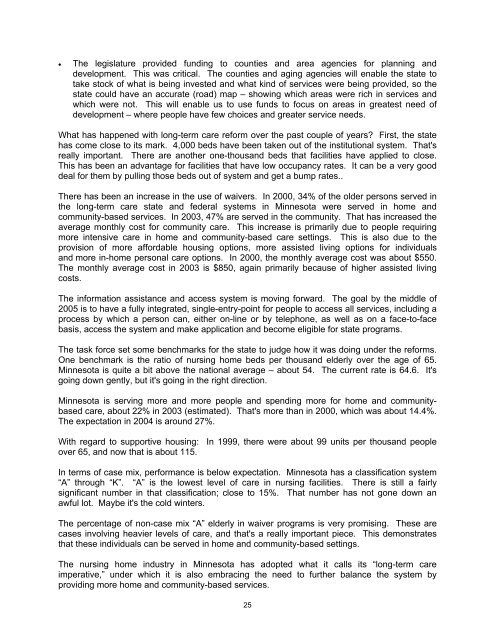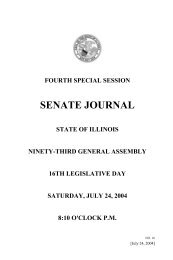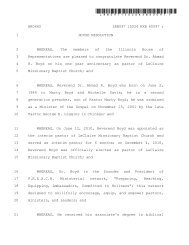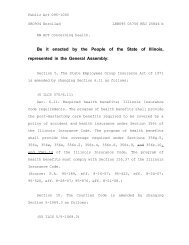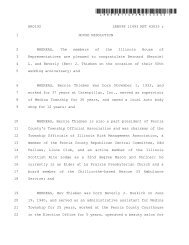Long-Term Care - Illinois General Assembly
Long-Term Care - Illinois General Assembly
Long-Term Care - Illinois General Assembly
Create successful ePaper yourself
Turn your PDF publications into a flip-book with our unique Google optimized e-Paper software.
• The legislature provided funding to counties and area agencies for planning and<br />
development. This was critical. The counties and aging agencies will enable the state to<br />
take stock of what is being invested and what kind of services were being provided, so the<br />
state could have an accurate (road) map – showing which areas were rich in services and<br />
which were not. This will enable us to use funds to focus on areas in greatest need of<br />
development – where people have few choices and greater service needs.<br />
What has happened with long-term care reform over the past couple of years? First, the state<br />
has come close to its mark. 4,000 beds have been taken out of the institutional system. That's<br />
really important. There are another one-thousand beds that facilities have applied to close.<br />
This has been an advantage for facilities that have low occupancy rates. It can be a very good<br />
deal for them by pulling those beds out of system and get a bump rates..<br />
There has been an increase in the use of waivers. In 2000, 34% of the older persons served in<br />
the long-term care state and federal systems in Minnesota were served in home and<br />
community-based services. In 2003, 47% are served in the community. That has increased the<br />
average monthly cost for community care. This increase is primarily due to people requiring<br />
more intensive care in home and community-based care settings. This is also due to the<br />
provision of more affordable housing options, more assisted living options for individuals<br />
and more in-home personal care options. In 2000, the monthly average cost was about $550.<br />
The monthly average cost in 2003 is $850, again primarily because of higher assisted living<br />
costs.<br />
The information assistance and access system is moving forward. The goal by the middle of<br />
2005 is to have a fully integrated, single-entry-point for people to access all services, including a<br />
process by which a person can, either on-line or by telephone, as well as on a face-to-face<br />
basis, access the system and make application and become eligible for state programs.<br />
The task force set some benchmarks for the state to judge how it was doing under the reforms.<br />
One benchmark is the ratio of nursing home beds per thousand elderly over the age of 65.<br />
Minnesota is quite a bit above the national average – about 54. The current rate is 64.6. It's<br />
going down gently, but it's going in the right direction.<br />
Minnesota is serving more and more people and spending more for home and communitybased<br />
care, about 22% in 2003 (estimated). That's more than in 2000, which was about 14.4%.<br />
The expectation in 2004 is around 27%.<br />
With regard to supportive housing: In 1999, there were about 99 units per thousand people<br />
over 65, and now that is about 115.<br />
In terms of case mix, performance is below expectation. Minnesota has a classification system<br />
“A” through “K”. “A” is the lowest level of care in nursing facilities. There is still a fairly<br />
significant number in that classification; close to 15%. That number has not gone down an<br />
awful lot. Maybe it's the cold winters.<br />
The percentage of non-case mix “A” elderly in waiver programs is very promising. These are<br />
cases involving heavier levels of care, and that's a really important piece. This demonstrates<br />
that these individuals can be served in home and community-based settings.<br />
The nursing home industry in Minnesota has adopted what it calls its “long-term care<br />
imperative,” under which it is also embracing the need to further balance the system by<br />
providing more home and community-based services.<br />
25


